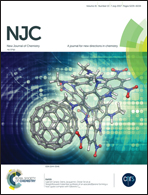Organic-to-aqueous phase transfer of Zn–Cu–In–Se/ZnS quantum dots with multifunctional multidentate polymer ligands for biomedical optical imaging†
Abstract
With the growing trials of biocompatible quantum dots (QDs) in biomedical applications, exploring the surface modification of oil-soluble QDs to increase their solubility in water is facing more challenges. Hence, in this report, we describe a new approach to synthesize oil-soluble highly luminescent Zn–Cu–In–Se/ZnS (ZCISe/ZnS) QDs with low cytotoxicity. Their photoluminescence (PL) emission could be tuned from 545 to 850 nm by optimizing a series of parameters, and the typical PL quantum yield (QY) is 40–60%. Then, to transfer these oil-soluble QDs into water, cRGD (c(Arg-Gly-Asp-D-Tyr-Lys) peptide) modified multifunctional multidentate polymer ligands (cRGD-PME) were fabricated. The phase transfer is based on a ligand-exchange process mediated by thioglycerol. The obtained results show that the cRGD-PME polymer can afford the formulation of the oil-soluble ZCISe/ZnS QDs in water, while retaining their initial morphology, crystal structure, and PL properties. Finally, in vitro and in vivo optical imaging experiments were further explored, indicating that the prepared aqueous ZCISe/ZnS QDs via cRGD-PME ligands have potential as a versatile fluorescent probe for evaluating tumor targeting in cells and small animals. This study is also particularly significant for developing new biocompatible QDs-based probes to take the place of previous CdSe or CdTe QDs-based ones.



 Please wait while we load your content...
Please wait while we load your content...